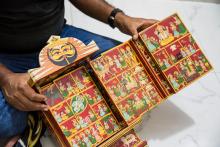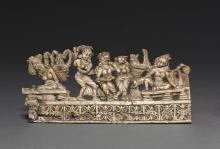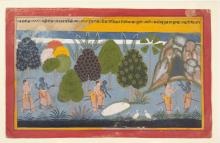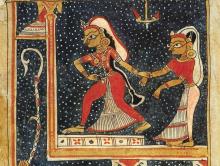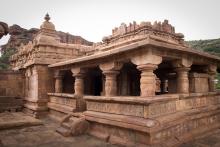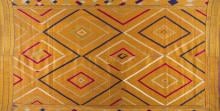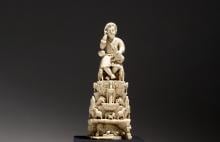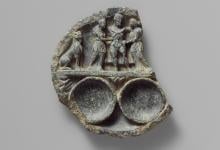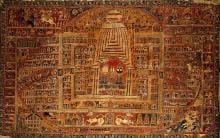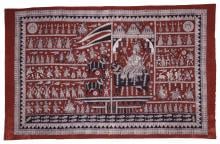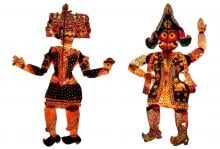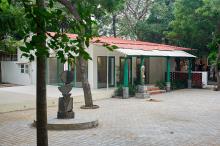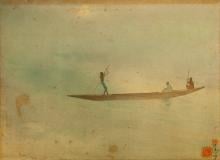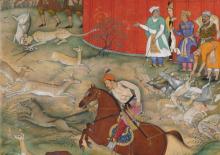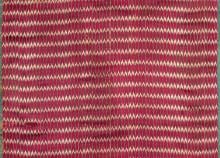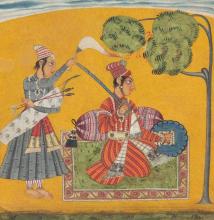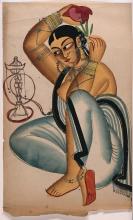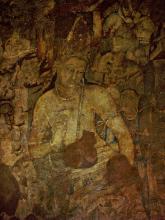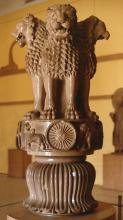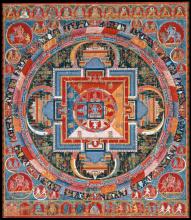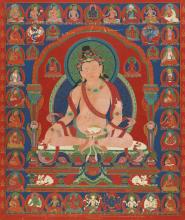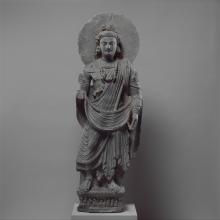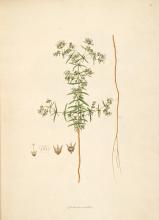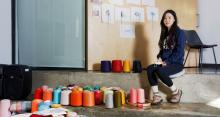Arts Visual Arts
News
15 Apr 2024
Once a two-armed attendant to the goddess Tara, over time, Marichi was increasingly endowed with power until she became a deity in her own right. Revered as a warrior and guardian against evil and darkness, Marichi’s imagery reveals myriad symbolisms — from her association with the sun to her role as a fierce protector. Read about the multifaceted nature of Marichi's mythology and imagery, spanning nations, cultures, and time.
01 Apr 2024
In India’s dry, western-most state — Rajasthan — the gods are carried from village to village, and tales that surround the deity are narrated so that the devout may be blessed. The gods are housed in a ‘kavad’, a portable shrine adorned with intricate narrative paintings of folk tales and epics. Constructed from low-density wood and painted with mineral-derived pigments, the kavad serves as a conduit for the oral storytelling tradition known as kavad banchana. Learn about the synergy between the makers, painters and patrons of these shrines, and how this tradition continues to evolve.
19 Mar 2024
In the late 1930s, French archaeologists discovered a large and remarkable group of ivory sculptures, in Afghanistan's Begram (present-day Bagram). Stipulated to have been used as accents or embellishments for wooden furniture, these carved objects showcase a blend of Greco-Roman, Central Asian, Mediterranean, and Indic stylistic influences. Despite the political upheavals in the region, some of these ivory artefacts still survive. Explore how ongoing scholarly efforts shed light on the historical significance of these art objects, highlighting the cultural connections that were built and flourished along the Silk Road.
04 Mar 2024
In the early seventeenth century, the royal ateliers of the Mewar kingdom, in present-day western India, witnessed the emergence of a new miniature painting tradition. The Mewar School, as it is known, was patronised by the ruling Sisodia dynasty. Stemming from manuscript illustration, this tradition evolved to encompass intricately detailed portraiture. Delve into the evolution of the Mewar School, tracing its distinct styles, aesthetic influences, master artists, and the shifting preferences of its royal patrons.
19 Feb 2024
Dated to the fourteenth century, the Chandayana is a Sufi romance that narrates the story of the lovelorn protagonists — Chanda and Laurik — in rhyming couplets. It was composed in the Awadhi dialect of Hindi, by the Chishti poet Mulla Daud. Five illustrated manuscripts of the poem were created between the fifteenth and sixteenth centuries, and they are housed in five different locations worldwide. These illustrated texts provide a lens into the history of manuscript paintings in the Indian subcontinent.
29 Jan 2024
Nestled in northern Karnataka, the Badami cave temples of India are adorned with a unique blend of intricate carvings that draw religious motifs from Shaivite, Vaishnavite and Jain traditions. Learn more about these 2nd-century rock-cut shrines that bear testament to ancient Indian royal patronage and religious syncretism.
15 Jan 2024
The Punjab regions of India and Pakistan bear witness to a centuries-old, laborious tradition of embroidering cloth with silk threads. Called Vari da Bagh and Bagh, meaning “‘garden”’, these textiles are ritually significant and are adorned with geometric patterns or motifs that draw from the everyday life and culture of the region.
01 Jan 2024
In the 16th and 17th centuries, religious ivory statuettes sculpted in colonial Goa sported a unique amalgamation of European and ancient Indian symbolisms. Discover the history of this Indo-Portuguese iconography and its ties to local evangelism, slavery and colonial export.
18 Dec 2023
Amongst the earliest objects unearthed from Gandhara are carved stone dishes depicting guardian spirits, mythical creatures and scenes of merrymaking. Despite the carvings being rich in artistic and cultural information, they reveal little about the functions of these objects. Learn more about these enigmatic artefacts, and the material history of ancient Gandhara.
04 Dec 2023
Since nearly the twelfth century, painters, called ‘patuas’, lived around the Jagannatha Temple at Puri in Odisha, painting tales from Hindu and Islamic religious mythologies, and local legends onto cloth scrolls. Discover how the rituals and festivals of the temple, and its principal deities — Jagannatha, Balabhadra, and Subhadra — inspire these paintings.
20 Nov 2023
Created by western India’s nomadic Vaghri community, mata ni pachedi is a tradition of cloth painting dating back 300 years. Originally meant as canopies for shrines and as objects of ritual worship, these textiles depict a pantheon of local goddesses surrounded by regional motifs. Read on to understand how printing, painting and cloth come together in religious consumerism.
06 Nov 2023
Since the 3rd century CE, master puppeteers of southern India have brought the epics of the subcontinent to life through Tholu Bommalata, a form of shadow puppetry performed with elaborate, life-sized leather puppets. Come discover this intricate musical theatre tradition that has been passed down from generation to generation and continues to thrive to this day.
20 Oct 2023
The Cholamandal Artists' Village was established in 1966 to encourage self-sufficiency, community living and the creation of a South Indian visual identity. Since then, it has undergone a transformative journey. Discover its history and achievements.
09 Oct 2023
Between the seventh and ninth centuries, south peninsular India experienced a cultural renaissance, resulting from the extensive patronage of a powerful dynasty, the Pallavas. Discover their unique contributions to the arts and literature of the time, which led to the creation of a new, Dravidian idiom of temple architecture in South Asia.
24 Sep 2023
Amidst the political tumult of nineteenth-century colonial India, Abanindranath Tagore — an artist from Bengal — set out to invent a new ‘Indian’ visual language, rejecting European artistic ideals. He pioneered a style that combined themes from mythology, history, and rural life, with elements from India’s miniature painting traditions. This would evolve into the Bengal School — a movement that reimagined a distinctly Indian approach to art. Tagore influenced an entire generation of artists and left a lasting impact on the quest for Indian identity during the struggle for Independence.
11 Sep 2023
In the mid-sixteenth century, Mughal emperor Humayun brought two Persian master painters to India, who not only established an imperial atelier but also began a major tradition of miniature painting in South Asia — Mughal manuscript paintings. This painting tradition flourished for centuries, enjoying royal patronage and resulted in the illustration of significant literary texts, scriptures, biographies, dynastic histories and scientific literature. Known for their naturalism and intricacy, Mughal paintings also combined a range of influences — Persian, Indian and European — and were often made collaboratively by artists and other specialists in the imperial ateliers, known as kitabkhanas. Discover the legacy and lasting influence of this painting tradition and its eventual decline in the late eighteenth century.
28 Aug 2023
Traditionally woven in Gujarat, India, mashru — meaning ‘lawful’ or ‘permitted’ in Arabic — was invented to allow Muslims to wear silk garments despite injunctions against it in the Hadith, an important Islamic religious text offering teachings and moral guidance. The fabric’s innovative weaving technique, where each silk warp crosses six cotton wefts, keeps silk from touching the body when worn. Whilst the earliest visual references to mashru date back to the seventeenth-century in the Deccan region of southern India, the fabric has lived many lives, gaining popularity amongst Islamic populations in India, West Asia and Africa as it was traded along Indian Ocean maritime routes.
14 Aug 2023
In the early seventeenth century, a new painting tradition — characterised by its use of bold colours, gilding and gem-setting — emerged in the Thanjavur region of southern India. While Thanjavur paintings originally featured gods and saints, the tradition grew to incorporate secular subjects owing to a range of influences over the next several centuries, including Mughal, Maratha, and European art. Thanjavur paintings continue to be popular as memorabilia and worship objects, and are one the most recognisable South Indian painting styles today.
04 Jun 2023
Beginning in the fifteenth century, until the nineteenth century, artists turned to classical music for inspiration, combining painting, allegory and music to create a genre known as Ragamala painting. Ragas — melodic frameworks central to Indian classical music — date back to nearly the fifth century, and each major raga is meant to evoke a particular mood or atmosphere, a season and a time of day. Ragamala paintings are distinctive for their nuanced depiction of emotions through environmental metaphors and imagery that often includes a hero or a heroine or both.
23 Apr 2023
Born out of the changing society of nineteenth-century Calcutta, Kalighat painting was a popular medium among the patuas (painters) who worked in the vicinity of the Kalighat temple. Though these paintings were originally intended to be souvenirs for devotees visiting the temple and featured primarily Hindu imagery, they expanded over time to include other religious traditions as well as socio-political commentary.
26 Feb 2023
Ajanta Murals represent some of India's earliest and most significant examples of cave painting. Spanning from the second and first centuries BCE to the late fifth CE, they narrate stories of the Buddha through his life as various bodhisattvas. Read on to discover the iconography, style and history of Ajanta Murals.
15 Jan 2023
Believed to have been built in 250 BCE to commemorate the occasion of the Buddha's first sermon in Sarnath, the lion capital is the most elaborately carved surviving capital made under the patronage of the Mauryan king Ashoka.
19 Dec 2022
Often used by devotees as a meditation tool, Mandalas are symmetrical circular forms that typically comprise a central deity surrounded by motifs and symbols.
08 Sep 2022
Thangka is a devotional scroll-painting tradition, emerging from seventh-century Nepal, in which images of Buddhist deities are painted on scrolls to gain divine merit and to serve as visual aids for teaching and meditating.
28 Aug 2022
Commissioned between 1815-1820, the Fraser Album is considered a defining work of the Company School of painting depicting the people of India.
14 Aug 2022
A genre of sculpture developed in the northwest region of the ancient Indian subcontinent in the form of reliefs and freestanding work as expressions of the Buddhist faith.
31 Jul 2022
The history of extracting chay root dye — a natural red colourant — from the chay plant (Oldenlandia umbellata) dates back to at least the seventeenth century. Read on to know more about the relevance of the dye in the textile dyeing practices of southern India.
03 Nov 2020
South Korea's Ulsan National Institute of Science and Technology (UNIST) has unveiled the second residency project, dedicated to blending art and science, has been conducted at the Science Cabin 215 of UNIST.
03 Nov 2020
South Korea's Ulsan National Institute of Science and Technology (UNIST) has unveiled the first residency project, dedicated to blending art and science, has been conducted at the Science Cabin 215 of UNIST.
Events

15 Oct 2020 to 25 Oct 2020
The Science Walden Center of South Korea's Ulsan National Institute of Science and Technology (UNIST), in collaboration with Artist Jieun Gu exhibited an art work, along the Taehwa River in Ulsan, S. Korea.

10 Sep 2019
South Korea's Ulsan National Institute of Science and Technology is delighted to announce the HFE Labs’ Demonstration Day is scheduled to be held on September 10, 2019.
Researchers
Sorry, nothing coming up for this discipline
Giants in history
Sorry, nothing coming up for this discipline



